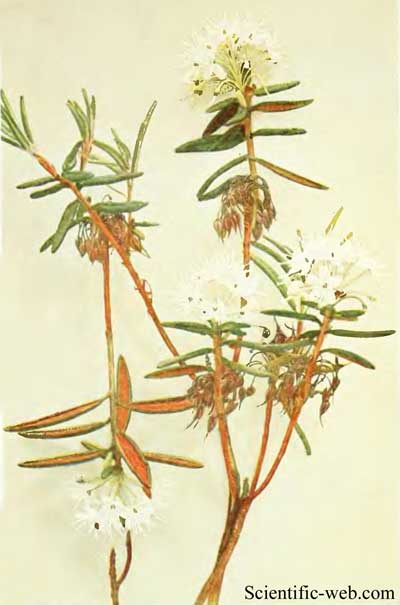
Rhododendron groenlandicum
Classification System: APG IV
Superregnum: Eukaryota
Regnum: Plantae
Cladus: Angiosperms
Cladus: Eudicots
Cladus: Core eudicots
Cladus: Asterids
Ordo: Ericales
Familia: Ericaceae
Subfamilia: Ericoideae
Tribus: Rhodoreae
Genus: Rhododendron
Subgenus: R. subg. Rhododendron
Sectio: R. sect. Rhododendron
Subsectio: R. subsect. Ledum
Species: Rhododendron groenlandicum
Name
Rhododendron groenlandicum (Oeder) Kron & Judd, Syst. Bot. 15: 67 (1990).
Synonyms
Ledum canadense Lodd.
Ledum groenlandicum Oeder
Ledum latifolium Jacq.
Ledum palustre Michx.
Ledum palustre subsp. groenlandicum (Oeder) Hulten
Ledum palustre var. latifolium (Jacq.) Hook.
Distribution
Native distribution areas:
Continental: Northern America
Alaska, USA (Connecticut, Idaho, Massachusetts, Maine, Michigan, Minnesota, North Dakota, New Hampshire, New Jersey, New York, Ohio, Oregon, Pennsylvania, South Dakota, Vermont, Washington State, Wisconsin), Canada (Alberta, British Columbia, Labrador, Manitoba, New Brunswick, Newfoundland, Nova Scotia, Northern Territories, Nunavut, Ontario, Prince Edward Isl., Quebec, Saskatchewan, Yukon), Greenland, St. Pierre et Miquelon
References: Brummitt, R.K. 2001. TDWG – World Geographical Scheme for Recording Plant Distributions, 2nd Edition
References
Primary references
Kron, K.A. & Judd, W.S. (1990) Systematic Botany 15: 67.
Links
Hassler, M. 2020. Rhododendron groenlandicum. World Plants: Synonymic Checklists of the Vascular Plants of the World In: Roskovh, Y., Abucay, L., Orrell, T., Nicolson, D., Bailly, N., Kirk, P., Bourgoin, T., DeWalt, R.E., Decock, W., De Wever, A., Nieukerken, E. van, Zarucchi, J. & Penev, L., eds. 2020. Species 2000 & ITIS Catalogue of Life. Published on the internet. Accessed: 2020 May 12. Reference page.
Govaerts, R. et al. 2020. Rhododendron groenlandicum in Kew Science Plants of the World online. The Board of Trustees of the Royal Botanic Gardens, Kew. Published on the internet. Accessed: 2020 May 12. Reference page.
International Plant Names Index. 2020. Rhododendron groenlandicum. Published online. Accessed: May 12 2020.
Tropicos.org 2020. Rhododendron groenlandicum. Missouri Botanical Garden. Published on the internet. Accessed: 2020 May 12.
USDA, ARS, Germplasm Resources Information Network. Rhododendron groenlandicum in the Germplasm Resources Information Network (GRIN), U.S. Department of Agriculture Agricultural Research Service. Accessed: 2020 May 12.
Vernacular names
English: Bog Labrador tea
suomi: Lännenpursu, grönlanninpursu
français: Thé du Labrador
Türkçe: Labradorçayı
Rhododendron groenlandicum (bog Labrador tea, Muskeg tea, Swamp tea, or in northern Canada, Hudson's Bay Tea;[2] formerly Ledum groenlandicum or Ledum latifolium),[3] is a flowering shrub with white flowers and evergreen leaves that is used to make a herbal tea.
Description
It is a low shrub growing to 50 centimetres (20 in) (rarely up to 2 metres (6 ft 7 in)) tall with evergreen leaves 20–60 millimetres (0.79–2.36 in) long and 3–15 millimetres (0.12–0.59 in) broad. The leaves are wrinkled on top, densely hairy white to red-brown underneath, and have a leathery texture, curling at the edges. The tiny white flowers grow in hemispherical clusters and are very fragrant and sticky.[4]
Distribution and habitat
Ledum latifolium drawn by William Miller
It is reported from Greenland, as well as from every province and territory in Canada and in the northeastern and northwestern United States (New England, New York, Pennsylvania, Michigan, Wisconsin, Minnesota, Idaho, Washington, and Alaska).
It grows in bogs, muskegs, and open tundra, as well as occasionally on wet shores and rocky alpine slopes.[5][6]
Uses
Bog Labrador tea leaves are regularly used to make beverages and medicines—most commonly a fragrant tea—by many Native American tribes such as the Quinault and Makah, the Potawatomi, the Anishinaabe, the Iroquois, and First Nations tribes in Canada.[6] When European explorers arrived, they soon adopted these uses as well, dubbing it "Indian plant tea".[6] During the Revolutionary War, it was used as a substitute for tea.[6]
It is sometimes grown as an ornamental shrub.[6]
Its essential oil is popular in aromatherapy.[6]
For its traditional uses in herbal medicine, see Labrador tea.
Precautions
Bog Labrador tea contains toxic alkaloids, which are poisonous to livestock and may be toxic to humans in concentrated doses.[6]
See also
Rhododendron (disambiguation)
List of Rhododendron species
List of rhododendron diseases
List of Award of Garden Merit rhododendrons
References
"Rhododendron groenlandicum (Oeder) Kron & Judd". Tropicos. Retrieved February 2, 2014.
Niering, William A.; Olmstead, Nancy C. (1985) [1979]. The Audubon Society Field Guide to North American Wildflowers, Eastern Region. Knopf. p. 502. ISBN 0-394-50432-1.
Kron, Kathleen Anne; Judd (1990). "Phylogenetic Relationships within the Rhodoreae (Ericaceae) with Specific Comments on the Placement of Ledum". Systematic Botany. 15 (1): 67. doi:10.2307/2419016. JSTOR 2419016.
Peterson, R. T. and McKenny, M. A Field Guide to Wildflowers Northeastern and North-central North America.
Kron, Kathleen A.; Judd, Walter S. (1990). "Rhododendron groenlandicum". Systematic Botany. Flora of North America. 15 (1): 57–68. doi:10.2307/2419016. JSTOR 2419016.
Anderson, M. (2011). Plant Guide for bog Labrador tea (Ledum groenlandicum) (PDF). Greensboro, NC.: USDA-Natural Resources Conservation Service, National Plant Data Team.
Retrieved from "http://en.wikipedia.org/"
All text is available under the terms of the GNU Free Documentation License

